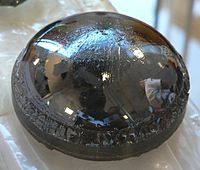
Photo from wikipedia
Abstract Silicon vacancy defects in 4H-SiC are promising candidates for quantum technology. However, the fabrication of controlled atomistic defects in 4H-SiC is still a challenge. In this work, we used… Click to show full abstract
Abstract Silicon vacancy defects in 4H-SiC are promising candidates for quantum technology. However, the fabrication of controlled atomistic defects in 4H-SiC is still a challenge. In this work, we used molecular dynamics (MD) simulations to study the mechanism of the evolution of silicon vacancy defects and damage during hydrogen ion implantation and subsequent annealing. By considering the electronic energy loss of hydrogen ions, the distribution of implanted hydrogen ions, and the atomic-scale mechanism of silicon vacancy defects and damage can be described more accurately. The results can observe the changing trend of silicon vacancy defects with the complete structure during the entire implantation and annealing process, and it is found that the local temperature generated by hydrogen ion implantation may affect the fluctuation of silicon vacancy defects. Besides, the yield of silicon vacancy defects can be improved by optimizing annealing conditions, and there is an optimal annealing temperature.
Journal Title: Diamond and Related Materials
Year Published: 2021
Link to full text (if available)
Share on Social Media: Sign Up to like & get
recommendations!